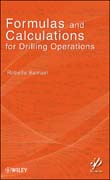
Presented in an easy-to-use format, Formulas and Calculations for Drilling Operations is a quick reference for day-to-day work out on the rig. It also serves as a handy study guide for drilling and well control certification courses. Virtually all the mathematics required on a drilling rig is here in one convenient source, including formulas for pressure gradient, specific gravity, pump, output, annular velocity, buoyancy factor, and many other topics. INDICE: Preface. 1 Basic Calculations. 1.1 Capacities. 1.2 Displacement. 1.3 Buoyancy, Buoyed Weight, and Buoyancy Factor (BF). 1.4 Effective Weight. 1.5Modulus of Elasticity. 1.6 Poisson's Ratio. 1.7 Minimum Yield Strength. 1.8 Ultimate Tensile Strength. 1.9 Fatigue Endurance Limit. 1.10 Twist. 1.11 Composite Materials. 1.12 Friction. 1.13 Gauge and Absolute Pressures. 1.14 Temperature. 1.15 Horsepower. 1.16 Flow Velocity. 2 Rig Equipment. 2.1 Overall Efficiency of Engines. 2.2 Energy Transfer. 2.3 Blocks and Drilling Line. 2.4 DerrickLoad. 2.5 Ton-Miles (TM) Calculations. 2.6 Crown Block Capacity. 2.7 Line Pull Efficiency Factor. 2.8 Rotary Power. 2.9 Mud Pumps. 2.10 Energy Transfer. 2.11 Offshore Vessels. 3 Well Path Design. 3.1 Average Curvature Average Dogleg Severity (DLS). 3.2 Vertical and Horizontal Curvatures. 3.3 Borehole Curvature. 3.4 Bending Angle. 3.5 Tool Face Angle. 3.6 Borehole Torsion. 3.7 Wellpath Length Calculations. 3.8 Types of Designs. 3.9 Tool Face Angle Change. 3.10 Horizontal Displacement. 3.11 Tortuosity. 3.12 Well Profile Energy. 3.13 MagneticReference and Interference. 3.14 Wellbore Trajectory Uncertainty. 4 Fluids. 4.1 Equivalent Mud Weight. 4.2 Mud Weighting. 4.3 Common Weighting Materials. 4.4 Diluting Mud. 4.5 Base Fluid Water-Oil Ratios. 4.6 Fluid Loss. 4.7 AcidityAlkalinity. 4.8 Marsh Funnel. 4.9 Mud Rheology. 4.10 Plastic Viscosity, Yield Point and Zero-Sec-Gel. 5 Hydraulics. 5.1 Equivalent Mud Weight. 5.2 EquivalentCirculating Density. 5.3 Hydraulics: Basic Calculations. 5.4 Bit Hydraulics. 5.5 Bingham Plastic Model. 5.6 Power Law Model. 5.7 Gel Breaking Pressure. 5.8Hole Cleaning Cuttings Transport. 5.9 Transport Velocity. 6 Tubular Mechanics. 6.1 Drill Collar Length. 6.2 Bending Stress Ratio (BSR). 6.3 Pipe Wall Thickness. 6.4 Resonant Frequency. 6.5 Tensions. 6.6 Drag Force. 6.7 Side Force Calculation. 6.8 Torque and Makeup Torque. 6.9 Buckling. 6.10 Maximum PermissibleDogleg. 6.11 Length Change Calculations. 6.12 Stresses. 6.13 Fatigue Ratio. 6.14 Bending Stress Magnification Factor. 6.15 Slip Crushing. 6.16 Cumulative Fatigue Calculation. 7 Drilling Tools. 7.1 Stretch Calculations. 7.2 Backoff Calculations. 7.3 Overpull/Slack-Off Calculations. 7.4 Motor Calculations. 7.5 Stabilizer Calculations. 7.6 Percussion Hammer. 7.7 Positive Displacement Motor(PDM). 7.8 Rotor Nozzle Sizing. 7.9 Downhole Turbine. 7.10 Jar Calculations. 7.11 Specific Energy. 8 Pore Pressure and Fracture Gradient. 8.1 Formation Pressure. 8.2 Leak-off Pressure. 9 Well Control. 9.1 Kill Mud Weight. 9.2 The Length and Density of the Kick. 9.3 Hydrostatic Pressure Due to the Gas Column. 9.4 Leak-off Pressure. 9.5 Maximum Allowable Annular Surface Pressure (MAASP). 9.6 Accumulators. 9.7 Driller's Method Operational Procedure. 9.8
- ISBN: 978-0-470-62599-6
- Editorial: John Wiley & Sons
- Encuadernacion: Rústica
- Páginas: 387
- Fecha Publicación: 27/10/2010
- Nº Volúmenes: 1
- Idioma: Inglés
